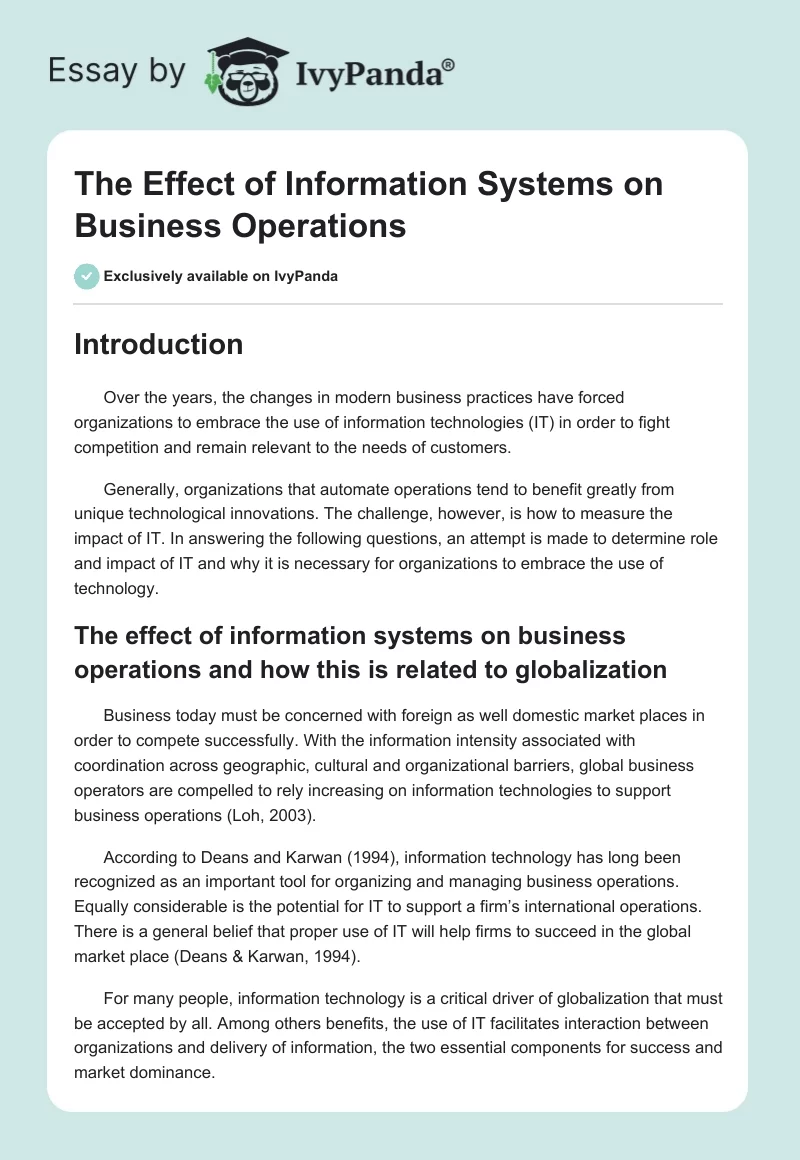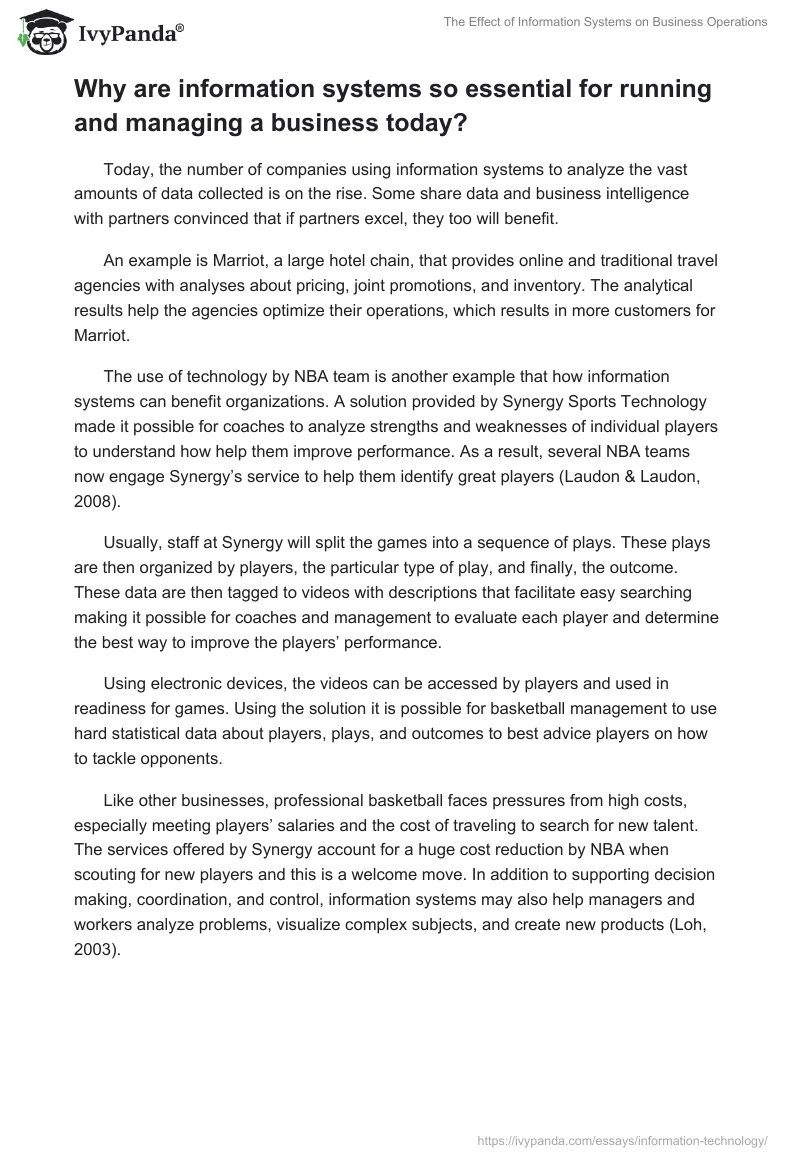Introduction
Over the years, the changes in modern business practices have forced organizations to embrace the use of information technologies (IT) in order to fight competition and remain relevant to the needs of customers.
Generally, organizations that automate operations tend to benefit greatly from unique technological innovations. The challenge, however, is how to measure the impact of IT. In answering the following questions, an attempt is made to determine role and impact of IT and why it is necessary for organizations to embrace the use of technology.
The effect of information systems on business operations and how this is related to globalization
Business today must be concerned with foreign as well domestic market places in order to compete successfully. With the information intensity associated with coordination across geographic, cultural and organizational barriers, global business operators are compelled to rely increasing on information technologies to support business operations (Loh, 2003).
According to Deans and Karwan (1994), information technology has long been recognized as an important tool for organizing and managing business operations. Equally considerable is the potential for IT to support a firm’s international operations. There is a general belief that proper use of IT will help firms to succeed in the global market place (Deans & Karwan, 1994).
For many people, information technology is a critical driver of globalization that must be accepted by all. Among others benefits, the use of IT facilitates interaction between organizations and delivery of information, the two essential components for success and market dominance.
Why are information systems so essential for running and managing a business today?
Today, the number of companies using information systems to analyze the vast amounts of data collected is on the rise. Some share data and business intelligence with partners convinced that if partners excel, they too will benefit.
An example is Marriot, a large hotel chain, that provides online and traditional travel agencies with analyses about pricing, joint promotions, and inventory. The analytical results help the agencies optimize their operations, which results in more customers for Marriot.
The use of technology by NBA team is another example that how information systems can benefit organizations. A solution provided by Synergy Sports Technology made it possible for coaches to analyze strengths and weaknesses of individual players to understand how help them improve performance. As a result, several NBA teams now engage Synergy’s service to help them identify great players (Laudon & Laudon, 2008).
Usually, staff at Synergy will split the games into a sequence of plays. These plays are then organized by players, the particular type of play, and finally, the outcome. These data are then tagged to videos with descriptions that facilitate easy searching making it possible for coaches and management to evaluate each player and determine the best way to improve the players’ performance.
Using electronic devices, the videos can be accessed by players and used in readiness for games. Using the solution it is possible for basketball management to use hard statistical data about players, plays, and outcomes to best advice players on how to tackle opponents.
Like other businesses, professional basketball faces pressures from high costs, especially meeting players’ salaries and the cost of traveling to search for new talent. The services offered by Synergy account for a huge cost reduction by NBA when scouting for new players and this is a welcome move. In addition to supporting decision making, coordination, and control, information systems may also help managers and workers analyze problems, visualize complex subjects, and create new products (Loh, 2003).
What exactly is an information system? How does it work? What are its people, organization, and technology components?
From a technical point of view, an information system (IS) may be defined as a set of components that are related and that can gather input, process it, and generate useful information for driving the business agenda (Laudon & Laudon, 2008). The processed information is very critical to decision making and helps to control business processes undertaken by organizations.
In addition, they are used in problem analysis, making predictions, creation of new products and services and coordinating business communications (Abramowicz, MacIaszek & Węcel, 2011). From the definition, an information system works by accepting input from an external source. Once fed into the system, the input is processed and may then be stored or distributed for various purposes.
For one to fully understand information systems, an awareness of the organization, people and technology which are the essential components that provide solutions to challenges and problems in the business environment, is important. According to Laudon and Laudon (2008), information systems are an integral part of any organization and even though it may appear that information systems create change in organizations, there is a close association between the two and they heavily influence each other.
How will a four-step method for business problem solving help you solve information system-relations problems?
The four-step method for business problem solving is based on the works of Deming. Planning is the first step and involves the establishment of objectives and processes for delivering results in accordance with the expected output.
The next step involves the implementation of the identified processes. In the third step, the results of new processes are compared with the expected output to identify any discrepancies. The final step deals with proving the differences noted and clarifying their causes (Abramowicz, MacIaszek & Węcel, 2011).
Generally, the four-step method offers a guideline commonly used by management to improve processes and operations to guarantee the best quality. A strict adherence to the steps will ensure that the quality is not compromised (Loh, 2003).
Important features of a business that make it possible to understand the role of information systems
According to Laudon and Laudon (2008), features of a business that are important for understanding the role of information systems include the level of operational excellence achieved, the development of new products and services, attainment of customer intimacy and service, improved decision making, and survival.
A number of companies have used information systems to improve quality and attract customers. Coca-Cola is an example of an international company that implemented an information system to protect product quality in 200 hundred countries. An information system also enables firms to respond quickly to customer requests for information or new products.
Describe the information systems supporting the major business functions: sales and marketing, manufacturing and production, finance and accounting, and human resources.
The sales and marketing system ensures that an organization is able to sell its products or services. While marketing is generally concerned with identification of customers for the organization’s products or services, and determining what they need or want, sales deals with contacting customers, ensuring the products and services are sold, taking customer orders, and making a follow up on sales (Laudon & Laudon, 2008).
The sales and marketing system is therefore designed to facilitate a smooth interaction between customers and the sales and marketing team. It may be integrated with other systems such as finance and accounting for improved decision making.
Manufacturing and production systems are designed to help with planning, development, and maintenance of production facilities. Other tasks include setting production goals, acquisition and storage of raw materials and controlling inventory levels. These systems ensure that products are manufactured based on agreed standards and help to monitor the quality of products.
They may also be used to process customer orders and develop production schedules. In addition, they help to design products through computer assisted design or CAD, and manufacture items through computer assisted manufacturing or CAM (Abramowicz, MacIaszek & Węcel, 2011).
The finance and accounting systems are designed to help personnel record the company’s transactions in the books of accounts. They are useful for recording accounts receivable when sales are made and cash receipts when customers send in payments.
They also help to record accounts payable when raw materials are purchased and cash outflows when payments are made for materials. These systems are also used to summarize transaction data when preparing reports about the company’s financial position and profitability.
The human resources systems are designed to create and maintain human resource details. They help in recruiting, hiring, training, and compensating employees. They are also useful for employee evaluation and ensuring compliance with government regulations (Loh, 2003).
A good human resource system should make it possible for human resource personnel to maintain a reliable database of skills for jobs and prevailing pay rates. Inputs to a human resource system include personnel forecasts and skills data while outputs include employee training and certification among others.
How will information systems affect business careers and what information systems skills and knowledge are essential?
As pointed out earlier, there have been major advancements in technology over the years that have forced information systems professionals to equally work hard to stay abreast with such changes. As we move into the future it is quite clear that the amount of skill and competence level the will be required of those coming into the information systems field will increase tremendously (Deans & Karwan, 1994).
Information systems professionals will be required to develop a strategic rather than just a tactical orientation. They will need to cultivate a global perspective and become team players, rather than remain technically isolated. This is true especially because the world is becoming increasingly unified and global competition is here to stay.
Companies are constantly dealing with new kinds of suppliers and expanding into new markets. To remain relevant as an Information systems specialist, it is imperative for one to understand how things are changing and position him or herself strategically. They must also develop an understanding of how technology affects people and the way they work (Deans & Karwan, 1994).
Conclusion
From the discussions presented in this paper, it is clear that the use of information technologies will place an organization on a very competitive edge. For this to happen, however, management needs to understand the role played by IT. The organization must therefore be structured in a way that will enable it to benefit from IT professionals as well as different technological components.
References
Abramowicz, W., MacIaszek, L. & Węcel, K. (2011). Business Information Systems Workshops: BIS 2011 International Workshops and BPSC International Conference, Poznań, Poland, June 15-17, 2011, Revised Papers. New York: Springer.
Deans, P. C. & Karwan, K. R. (1994). Global Information Systems and Technology: Focus on the Organization and Its Functional Areas. Harrisburg, PA: Idea Group Inc.
Laudon, J. & Laudon, K. (2008). Essentials of Management Information Systems, 8th Edition. Upper Saddle River, NJ: Prentice Hall.
Loh, P. (2003). Global IT Education and Training for the New Economy. Peninsula Plaza, Singapore: Knowledgeworks Consultants.


